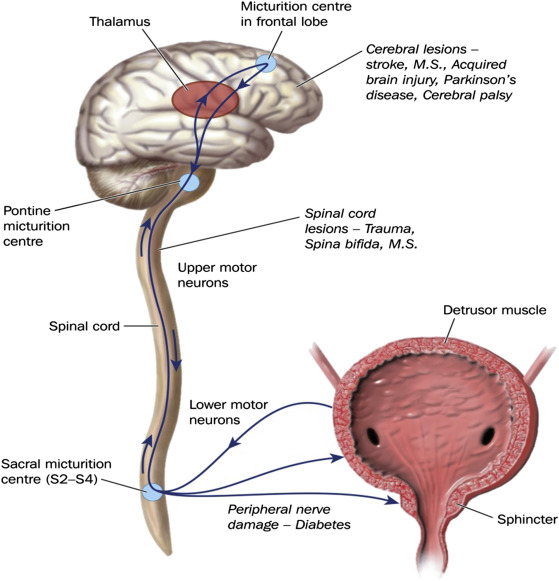Neurogenic detrusor overactivity (NDO) is a condition characterized by involuntary contractions of the detrusor muscle due to neurological impairment. This results in urinary urgency, incontinence, and potential kidney damage if left untreated. NDO commonly occurs in individuals with spinal cord injuries, multiple sclerosis, stroke, or other neurological disorders. Effective management involves medications, catheterization, neurostimulation, and surgical options.

Understanding Neurogenic Detrusor Overactivity
1. How the Bladder Functions
The urinary bladder stores and expels urine through coordinated interactions between the detrusor muscle, urethral sphincters, and the nervous system.
- Detrusor muscle: Contracts to expel urine.
- Internal and external sphincters: Control urine flow.
- Central and peripheral nervous system: Regulate voluntary and involuntary bladder control.
In healthy individuals, the detrusor muscle remains relaxed during urine storage and contracts only when the bladder is full. However, in NDO, the detrusor contracts involuntarily, leading to frequent and uncontrollable urination.
Causes of Neurogenic Detrusor Overactivity
NDO is primarily associated with neurological damage that disrupts normal bladder control. The most common causes include:
1. Spinal Cord Injuries (SCI)
- Complete or incomplete SCI disrupts nerve signals between the brain and bladder.
- Lesions above the sacral spinal cord often result in NDO with high bladder pressures.
2. Multiple Sclerosis (MS)
- Demyelination of nerves affects bladder control, causing detrusor hyperreflexia.
3. Stroke and Brain Injuries
- Damage to the brain’s micturition centers leads to loss of bladder inhibition, causing overactivity.
4. Parkinson’s Disease
- Dopaminergic dysfunction affects bladder reflexes, leading to involuntary contractions.
5. Spina Bifida and Congenital Disorders
- Neural tube defects disrupt normal nerve pathways, causing bladder dysfunction from birth.
6. Diabetes Mellitus
- Diabetic neuropathy damages bladder innervation, leading to detrusor overactivity.
Symptoms of Neurogenic Detrusor Overactivity
Individuals with NDO experience uncontrolled detrusor contractions, leading to:
✅ Urinary urgency – Sudden and strong urge to urinate
✅ Urinary incontinence – Involuntary urine leakage
✅ Frequent urination – Increased daytime and nighttime urination
✅ Incomplete bladder emptying – May cause residual urine buildup
✅ Urinary tract infections (UTIs) – Due to poor bladder emptying
✅ Bladder wall thickening – Caused by chronic overactivity
Diagnosis of Neurogenic Detrusor Overactivity
1. Medical History and Physical Examination
- Assessment of neurological conditions and previous injuries.
- Bladder diary analysis to track urinary frequency and urgency.
2. Urodynamic Studies
- Cystometry: Measures bladder pressure and volume.
- Pressure-flow study: Assesses detrusor contractions and sphincter coordination.
3. Imaging Tests
- Ultrasound: Identifies post-void residual urine.
- MRI/CT scan: Detects spinal or brain abnormalities affecting bladder function.
4. Urine and Blood Tests
- Urinalysis: Screens for infections and kidney function issues.
- Serum creatinine: Evaluates kidney health.
Treatment Options for Neurogenic Detrusor Overactivity
1. Pharmacological Management
- Anticholinergic drugs (Oxybutynin, Tolterodine): Inhibit involuntary detrusor contractions.
- Beta-3 adrenergic agonists (Mirabegron): Enhance bladder relaxation.
- Botulinum toxin (Botox) injections: Temporarily paralyze detrusor muscle.
2. Catheterization Techniques
- Intermittent catheterization: Preferred for patients with incomplete emptying.
- Indwelling catheters: Used in severe cases but increase infection risk.
3. Neuromodulation and Surgical Interventions
- Sacral neuromodulation: Electrical stimulation of sacral nerves to regulate bladder function.
- Dorsal rhizotomy: Surgical procedure to reduce detrusor overactivity.
- Bladder augmentation (enterocystoplasty): Expands bladder capacity to lower pressure.
4. Behavioral and Lifestyle Modifications
- Bladder training: Timed voiding to improve control.
- Pelvic floor exercises: Strengthen muscles to reduce incontinence.
- Fluid management: Avoid caffeine and alcohol to prevent urgency.
Complications of Untreated Neurogenic Detrusor Overactivity
Without proper treatment, NDO can lead to severe complications:
❌ Kidney damage due to high bladder pressure
❌ Hydronephrosis (urine backflow into the kidneys)
❌ Frequent UTIs from incomplete bladder emptying
❌ Bladder stones due to residual urine stagnation
❌ Severe incontinence affecting quality of life
Prognosis and Long-Term Management
- Regular monitoring with urodynamic studies is essential to prevent complications.
- Early intervention with medications, catheterization, or surgery improves outcomes.
- Multidisciplinary care involving neurologists, urologists, and physical therapists optimizes patient care.
Neurogenic detrusor overactivity is a serious condition that causes involuntary bladder contractions due to nerve dysfunction. Effective management requires a combination of medications, catheterization, neuromodulation, and surgery. Early diagnosis and proper treatment improve quality of life and prevent long-term complications like kidney damage and infections. Ongoing research in nerve stimulation therapies offers promising advancements in bladder control solutions.